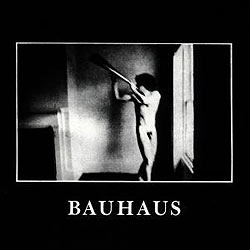Bauhaus, In The Flat Field
Published on November 29th, 2010 in: Issues, Music, Music Reviews, Reviews, Three Of A Perfect Pair |By Less Lee Moore
I first heard Bauhaus through a friend of a friend, but I first heard OF the band thanks to my frequent trips to Lakeside Mall as a teenager.
There was a cool-looking Chinese punk dude who also went to the mall frequently. He had spiky hair and wore a leather motorcycle jacket and a black T-shirt that said BAVHAVS. (I was soon to discover that he was a total lameass poseur, but that’s a story for another time and place.) In my ignorance, I thought that the band was actually called Bav-Haves until the aforementioned friend of a friend (or someone who took pity on me) set me straight.
Ah, those halcyon pre-Internet days.
At first, the only Bauhaus album I had was the 1979 – 1983 double LP. Mask and The Sky’s Gone Out soon followed. It wasn’t until just after the “Resurrection” tour of 1998 that I finally got In The Flat Field. I’d been intimately familiar with most of the songs before I had the album proper, having heard them either on the 1979 – 1983 comp or tapes I made from WTUL. I was also intimately familiar with Peter Murphy’s marvelous cheekbones, having stared at the photo inserts of the 1979 – 1983 album for many hours on end.

Although popular consensus classifies Bauhaus as Goth or Proto-Goth, I’ve always maintained that they had more in common with Glam and Art Rock than anything else. (Come on, covers of Bowie, Eno, and T.Rex? Seriously.) Ironically, In The Flat Field is probably their most Goth album, yet it’s also my favorite (with perhaps the exception of the Daniel Ash-heavy Burning From The Inside).
“Dark Entries” as the opening track could not have been an accident. In many ways, it does set the tone for the rest of the album: Murphy’s weird, flat chants and yelps set against the unsettling backdrop of guitar feedback and squeals, heavy bass, and marching band drumbeats. Say what you want about Bauhaus and their frequent pretentiousness: they were fucking COOL.
After the pummeling beats of “Dark Entries,” the next song, “Double Dare” almost seems leaden, like some ridiculous version of an old Black Sabbath tune. It all sounds atonal and unhinged, something that would certainly drive parents crazy. Murphy ramps up the crazy vocal acrobatics and there’s scarcely a chorus in sight. (This style would reach its apex in the almost-unlistenable “Swing The Heartache” from 1982’s The Sky’s Gone Out.)
Both David J’s bass and Kevin Haskins’ drumming are just fantastic on “In The Flat Field,” like some kind of controlled, bubbling cauldron. (Although I didn’t consciously realize it then, Haskins’ style is awfully similar to the “Burundi Beat” drumming of Adam and the Ants, who I adored then and now.) Here we are also introduced to Murphy’s terrifically ludicrous, nonsensical lyrics: Yin and Yang lumber punch/Go taste a tart, then eat my lunch. What the eff, dude. Still, it sounds really good.
It puzzles me that “God In An Alcove” didn’t make it onto 1979 – 1983 as it’s definitely one of Bauhaus’s best songs, both lyrically and in terms of Daniel Ash’s guitar playing. (Okay, maybe the “Now I am silly” bit is a bit . . . silly.)
Damn it if “Dive” doesn’t full on rock, as much as a band like Bauhaus could rock, with cacophonous saxophone courtesy of Daniel Ash (and lyrics not unlike Duran Duran’s “Late Bar” from their own debut album). I’m also particularly enamored of “Spy in the Cab” with its squelchy, squirty keyboard flourishes and flair for espionage. Here Murphy actually sings instead of screaming. The ending vocalizations must have influenced a very young Brian Warner a.k.a. Marilyn Manson.
“Small Talk Stinks” is next, and the title says it all. You can also hear David J. on vocals. To me, this is an archetypal Bauhaus song, the kind that separates the casual fan from the hardcore one.
Before I got the album proper, I must have listened to my crappy tape of “St. Vitus Dance” dozens of times when I was 15, desperately trying to discern what the hell Peter Murphy was singing. The Jew’s-harp-style keyboards fascinated me to no end, as did Murphy’s ability to shriek like a crazed banshee at the end. (The WTUL DJ who played this called it “St. Vitrus Dance,” which still makes me laugh.)
Still, in terms of sheer self-indulgent lunacy, nothing can top “Stigmata Martyr.” David J’s low, insistent bass, which would later come to comprise most of the post-Bauhaus project Tones on Tail, is omnipresent. As a recovering Catholic and someone who simultaneously adored and was terrified of The Exorcist, it was impossible not to be totally enthralled by Daniel Ash’s outlandish guitar feedback and Murphy’s Latin chanting.
The album ends with the seven-minute-plus “Nerves,” featuring more of that rolling Haskins drumbeat offset by plinky, out of place piano. There is also something completely satisfying about Peter Murphy’s voice here.
Although I had more than one argument with people back in the day over whether or not Bauhaus sucked or was truly awesome, I still like them, even though in retrospect, I admit that the arguments of pretentiousness are not without some merit.
Time limit is exhausted. Please reload the CAPTCHA.